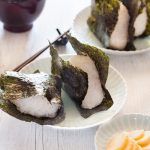
Onigiri (おにぎり, Japanese rice ball) is like a sandwich in Western culture. Why don’t you take rice balls wrapped in yaki nori (roasted seaweed sheet) with grilled salted salmon for lunch? It’s such a simple food but it is so comforting and tasty that you can’t stop eating. Instead of salmon or other popular protein, you can add pickled vegetables or pickled salty plum to make it 100% vegetarian. The shape can be flat and round instead of triangle.
- 120g (4.2oz) grilled salmon with salty flavour , broken into small chunks (note 1)
- 2½ cups cooked rice (hot or warm, note 2)
- a bowl of water (about 1 cup)
- 1 tsp salt in a little shallow bowl/plate (note 3)
- 4 x ½ size yaki nori sheet (note 4)
-
Place a cutting board in front of you and arrange salmon and the onigiri ingredients around it.
-
Add ¼ of the cooked rice to a tea cup or a small rice bowl of 150-180ml (5-6 oz), then turn it over and place the rice on the cutting board.
-
Wet your finger with water and make a well in the centre of the rice using your finger.
-
Add ¼ of the salmon pieces to the well.
-
Wet both palms of your hands with water, then take about ¼ of the salt and rub both palms together to spread the salt over them.
-
Pick up the rice from both sides by making a cup with your hands so that the rice will sit in your palms.
-
Using your thumbs, press down the salmon and then gather the rice around to cover the salmon and bury it in the centre (note 5) and make a rice ball.
-
Place the rice ball on the palm of the left hand, then place your right hand over the rice ball perpendicular to your left hand.
-
Then using mainly three fingers (index finger, middle finger and ring finger), squeeze the rice ball with both hands to shape it into a triangle. The left hand should control the thickness of the onigiri to make it about 4cm (1 ½”) thick and the right hand should shape the triangle. Press firmly but not too tight (note 6).
-
While pressing firmly, occasionally roll the triangle and press to make the onigiri more like an equilateral triangle.
-
Place the onigiri in the centre of a yaki nori sheet and cover both sides of the triangular surface with yaki nori.
-
Repeat for the remaining 3 onigiri (note 7).
1. Grilled salmon with salty flavour is a typical Japanese way of grilling salmon. Before grilling, sprinkle ½ teaspoon of salt (for this size) all over the salmon and leave it for 15 minutes. Then grill it just like grilling any fish.
2. Use short grain rice (preferable) or medium grain rice as the grains need to have starch to stick to each other. Please cook the rice in the way the Japanese do, ie. absorption method. You can visit my post How to Cook Rice The Japanese Way for that.
3. The amount of salt required varies depending on how salty you like the outside of the onigiri to be. You just need to try and adjust.
4. Yaki nori (焼き海苔) is roasted seaweed sheet. A full size yaki nori sheet is 19cm x 21cm (7½” x 8¼”). Cut in the centre vertically along the longer side.
You can make the size of yaki nori sheet much smaller per onigiri if you like as there are no rules to it. You don’t even have to have yaki nori but I find that it is easier to eat onigiri with yaki nori because otherwise the rice will stick to your hands.
5. Check to make sure the salmon is in the middle of the rice ball. If you can see a piece of salmon sticking out or placed very close to the surface of the onigiri, take some rice from the corner of the triangle and cover the salmon.
6. Insufficient firmness will make the rice ball fall apart when picked up or while eating.
7. I usually place 4 mounds of rice on the cutting board at once and do each step for all of them. This seems to be most efficient.